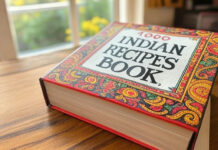
Bombay halwa recipe with instructions in detail. Mumbai halwa, also known as Karachi halwa, is tender and melts in the tongue. The main components of Bombay halwa are maize flour, ghee, water, and sugar. I decided to publish the recipe for Mumbai halwa because I had received requests to do so. Bombay halwa is simple to make and doesn’t require much time.
Made of what is Bombay Halwa?
This dessert, which is created with cornflour, sugar, and water, has a soft and chewy texture. Typically, it has an orange or crimson hue and is cardamom and ghee-flavored. When left at room temperature, the texture is soft and chewy, much like fudge or toffee.
Introduction to Bombay Halwa:
Bombay Halwa is a traditional Indian dessert that hails from the vibrant city of Mumbai (formerly Bombay), and is famous for its rich, luxurious texture and sweetness. This popular sweet treat is a beloved delicacy enjoyed during festive occasions, family gatherings, and celebrations. Known for its gelatinous, melt-in-your-mouth consistency, Bombay Halwa is a visually stunning dessert that is often served in colorful layers or garnished with nuts to enhance both its look and flavor. If you’re looking for a dessert that captures the essence of Indian cuisine with its aromatic spices and indulgent sweetness, Bombay Halwa is the perfect choice.
Roots of Bombay Halwa:
Mumbai Halwa is made primarily from semolina (rava or suji), sugar, ghee (clarified butter), and a few other key ingredients like cardamom, saffron, and cashews or almonds for garnish. The semolina is cooked with water and sugar until it reaches a thick, jelly-like consistency. The addition of ghee gives it a rich, velvety texture, while the fragrant cardamom and saffron infuse the dish with aromatic flavors. Once cooked, the mixture is spread into a tray and allowed to set, often garnished with nuts to add crunch and extra flavor.
The beauty of Mumbai Halwa lies in its ability to balance sweetness and texture. It’s not too heavy, making it a delightful dessert to end any meal. The vibrant yellow-orange color of the halwa, often from saffron or food coloring, adds to its visual appeal, making it a favorite for festive occasions like Diwali, weddings, and other cultural celebrations. Whether served warm or chilled, Mumbai Halwa is a decadent treat that embodies the spirit of indulgence and celebration in Indian culture.
Ingredient used in Mumbai Halwa Recipe :
- ½ cup cornflour
- 1 cup sugar
- ½ cup clarified butter
- 3 tablespoons chopped cashew nuts
- ¼ teaspoon cardamom powder
- Food colour
How to prepare Bombay Halwa:
- Take a bowl add sugar and ½ cup water bring it to a boil.
- In a small bowl mix ¾ water and corn flour well so that it does not have any lumps.
- In a non stick pan add 1 tablespoon of clarified butter and cornflour mixture to it and mix, then turn on the flame very low.
- When the mixture is thickening, switch off the flame and add sugar syrup little by little and keep mixing to avoid lumps repeat the same till syrup is finished.
- Turn on the flame and keep mixing the mixture. Now add ghee very slowly keep mixing repeat the same process till the ghee is finished.
- Now add colour, cardamom powder cook till clarified butter comes out.
- Add cashew nuts mix well once it comes into thick jelly consistency; transfer it to a greased plate with clarified butter.
- Let it sets for 1hr and cut into small pieces.
- Serve Bombay halwa and enjoy the flavour of India.
Watch video recipe for Bombay Halwa on youtube:
EXTRA KNOWLEDGE:
HOW COME IT IS NAMED KARACHI HALWA?
Although Bombay Halwa has an Indian dessert-like name, it actually has Pakistani roots. The name of this dish is derived from the Pakistani city of Karachi. It is also known as Bombay Karachi Halwa, and following the partition of India and Pakistan, halwais from Karachi moved to Bombay, India, popularizing the dish.
Top Tips for Making the Perfect Bombay Halwa:
- Use Fine Semolina (Rava):
The key to a smooth and soft Bombay Halwa is using fine semolina (rava). Coarse semolina may result in a grainy texture that is less desirable. - Cook Slowly Over Low Heat:
Be patient while cooking the semolina mixture. Cooking on low heat ensures that the semolina absorbs the liquids properly, and it helps create the desired smooth, gelatinous texture. - Constant Stirring is Crucial:
Stir the mixture constantly to prevent lumps and burning. This helps to achieve the velvety consistency for which Bombay Halwa is known. - Use Ghee for Richness:
Ghee is an essential ingredient that adds richness and a deep flavor to the dessert. Don’t skimp on the ghee, as it’s what gives Bombay Halwa its luxurious, melt-in-your-mouth texture. - Infuse with Saffron for Extra Aroma:
Soak a few strands of saffron in warm milk and add it to the halwa mixture. Not only will it impart a beautiful golden hue, but saffron also enhances the flavor with its distinct, aromatic essence. - Garnish with Fresh Nuts:
Top the halwa with roasted cashews, almonds, or pistachios for an extra crunch and visual appeal. Roasting the nuts lightly in ghee before adding them on top adds to the overall flavor. - Let It Set Well:
After cooking, allow the halwa to cool and set in the tray for at least 30-45 minutes. This helps the dessert firm up and develop the right consistency.
Frequently Asked Questions About Mumbai Halwa:
- Can I make Bombay Halwa without ghee?
- While ghee is traditional and gives Bombay Halwa its rich flavor and texture, you can substitute it with unsalted butter or vegetable oil if you prefer a lighter version or need a dairy-free alternative.
- Is Bombay Halwa gluten-free?
- Yes, Bombay Halwa is naturally gluten-free as it’s made with semolina (rava), which doesn’t contain gluten. However, make sure to check the packaging of semolina if you’re using a store-bought version to ensure it’s processed in a gluten-free facility.
- Can I add more flavors to Bombay Halwa?
- Absolutely! You can experiment with other spices like nutmeg, cinnamon, or cardamom to personalize the flavor. You can also add rose water or vanilla essence for an aromatic twist.
- How can I store Bombay Halwa?
- Store Bombay Halwa in an airtight container in the refrigerator for up to 3-4 days. You can enjoy it either chilled or reheated. If the halwa firms up in the fridge, simply warm it slightly before serving.
- Can I make Mumbai Halwa ahead of time for a party?
- Yes! Bombay Halwa is great for making ahead of time. You can prepare it the day before and refrigerate it. Just allow it to come to room temperature or heat it up slightly before serving.
- Can I substitute the semolina with other grains?
- While semolina is traditional, you can experiment with rice flour or cornstarch as alternatives, but keep in mind the texture and taste may vary from the classic Bombay Halwa.
- How can I make Mumbai Halwa less sweet?
- If you prefer a less sweet version, you can reduce the amount of sugar or try using jaggery or honey as a natural sweetener to adjust the sweetness level to your taste.
Read more recipes on: Lobia Masala Recipe














